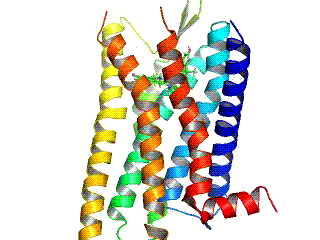Opioid receptors

Opioid receptors are specific, cellular binding sites (receptors) for opioids . These binding sites can be found in many animal species and in the human brain. Usually they bind the body's own (endogenous) peptides. The first identification of opioid receptors took place in 1973 by Candace Beebe Pert (1946-2013) and Solomon H. Snyder .
Opioid receptors in the human nervous system
Opioid receptors are located in the central and peripheral nerve tissue; a higher density is found in the thalamus . Endogenous ligands and opioid-containing narcotic analgesics dock to the opioid receptors . According to O. Schaumann's hypothesis, endogenous opioids belong to a protective system, the evolutionary sense of which is to dampen the reactions triggered under a stressful situation, as these hinder the survival of the individual. Opioid peptides are the natural ligands of the opioid receptors. The corresponding amino acid sequences of the ligands, or better their steric structure or spatial folding, interact with the same receptor components as those of the synthetic opioids or alkaloids. The pain relievers can be natural ( morphine ) and synthetic ( fentanyl ). Even opioid - antagonist such as naloxone or naltrexone take effect on the opioid receptors. Not all opiates (constituents of opium) bind to opioid receptors.
Endogenous peptides
The body's own ligands are: endorphin ( synonym : endomorphin), enkephalin , metorphamide and dynorphin .
Receptors
The following receptors are known: μ, κ, δ, ε, ORL ; they can be further broken down into their sub-receptors. The listed receptors are G-protein coupled . The activation of an opioid receptor and the G-protein coupled with it triggers the following effects in the synapse:
a) Inhibition of adenylate cyclase ( µ or OP 3 , κ or OP 2 )
b) Activation of potassium channels (potassium outflow from the cell, hyperpolarization , µ or OP 3 , κ or OP 2 )
c) inhibition of voltage-dependent calcium channels ( κ or OP 2 )
- µ 1 receptor : occurs presynaptically. Its signal transduction pathway leads to a lowering of cAMP via a G protein . This reduces the calcium influx and there is less transmitter release. The effects of the µ 1 receptor are analgesia (spinal and supraspinal), hypothermia , euphoria and miosis .
- Agonists: endorphin , enkephalin , morphine , 4-anilinopideridine derivatives such as fentanyl , certain psychotropic drugs such as tianeptine
- Partial agonist : buprenorphine
- Antagonists: naloxone , naltrexone (both types-unspecific)
- µ 2 receptor : occurs postsynaptically, has an inhibiting effect by increasing the probability of opening potassium channels ( hyperpolarization ). µ 2 agonism reduces the reaction to increased pCO 2 and thus causes respiratory depression. It also reduces the propulsive motor function (digestive motor function) of the gastrointestinal tract. As a rule, substances act here with the same effects as on the µ 1 receptor; however, functionally selective ligands are known, for example tianeptine.
- δ-receptor : occurs presynaptically. It is associated with the analgesic effect at the spinal cord level . Of the endogenous opioids, the enkephalin binds preferentially to this receptor.
- κ receptor : is also responsible for spinal analgesia, but also for minor respiratory depression and sedation. Selective activation can lead to dysphoria . This limits the addiction potential for selective κ-receptor agonists. Interestingly, salvinorin A causes hallucinations through agonism at the κ receptor. (Roth et al. 2002) Dynorphins have a higher affinity for κ receptors than for the other opioid receptors. The relatively selective κ-agonist pentazocine has been out of trade since 2006 due to more severe side effects ( respiratory depression and dependence ).
- The function of the ε receptor is still unknown.
- The orphan receptor ( ORL for opioid receptor like ) is also a recent discovery.
- The σ-receptor is no longer counted among the opioid receptors. Initially, this receptor was considered an opioid receptor, since opioids develop their antitussive effect via this receptor, but neither endogenous opioids bind to this receptor, nor can the effect of selective σ1 ligands be blocked by naloxone / naltrexone . Interactions at the σ receptor can cause psychotomimetic effects. The antidepressants opipramol and fluvoxamine bind to σ-receptors, as does the atypical quetiapine .
Respiratory depression
Are generally must be noted that by decreased CO 2 -Sensitivity of central blood gas receptors and the absence of pain, a strong respiratory drive applies to all opioid - agonist can lead to deadly consequences respiratory depression. This is problematic because the strong development of tolerance often leads to a rapid increase in dose.
See also
literature
- BN Dhawan, F. Cesselin, R. Raghubir and others: International Union of Pharmacology. XII. Classification of opioid receptors . In: Pharmacol Rev . tape 48 , no. 4 , 1996, pp. 567–592 ( full text [PDF; 6.0 MB ]).
- E. Freye: Opioids in Medicine. 6th edition. Berlin / Heidelberg / New York 2004, ISBN 3-540-40812-6 .
- O. Schaumann: Analgesics and the "protective" system . In: The natural sciences . tape 41 , no. 4 , 1954, pp. 96–96 , doi : 10.1007 / BF00633888 (free full text).
Individual evidence
- ↑ Michael Heck, Michael Fresenius: Repetitorium Anaesthesiologie. Preparation for the anesthesiological specialist examination and the European diploma in anesthesiology. 3rd, completely revised edition. Springer, Berlin / Heidelberg / New York et al. 2001, ISBN 3-540-67331-8 , p. 804.
- ^ WR Martin, CG Eades, JA Thompson, RE Huppler, PE Gilbert: The effects of morphine- and nalorphine-like drugs in the nondependent and morphine-dependent chronic spinal dog . In: J. Pharmacol. Exp. Ther. tape 197 , no. 3 , 1976, p. 517-532 , PMID 945347 .